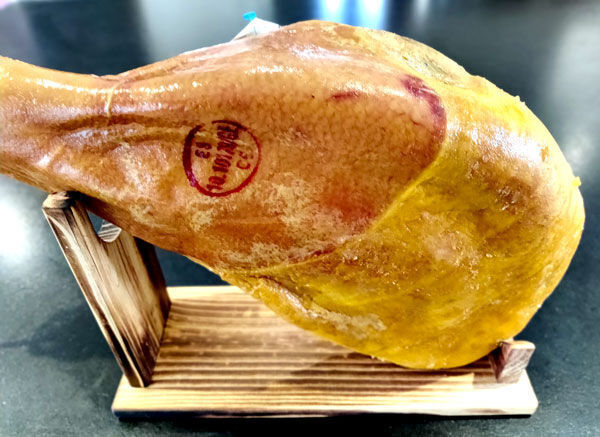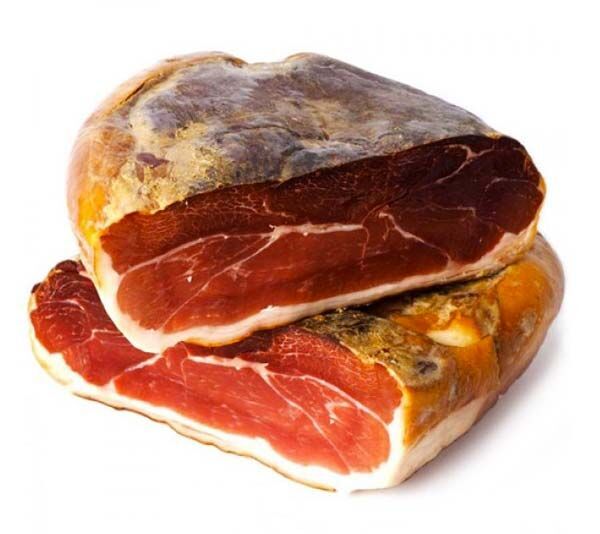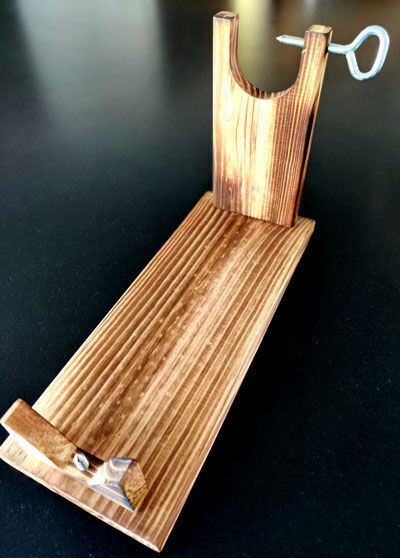Serrano ham
Serrano ham, this flagship product of Spanish gastronomy, has conquered palates around the world thanks to its unique flavor and delicate texture. But what do we really know about the history and origin of this exceptional ham? Let's dive into the past together to discover the secrets of Serrano ham.
The history and origin of Serrano ham.
The history of Serrano ham goes back several centuries. Its name, "Serrano", means "of the mountain" in Spanish. In fact, this ham owes its name to the tradition of drying at altitude, in the mountains of Spain, where the cold and dry air allows optimal maturation.
The history dates back to Roman times. The Romans salted pork to keep it longer. However, Serrano ham's popularity really exploded in the Middle Ages, when Spanish kings began giving these hams as diplomatic gifts.
Serrano Hams
Sliced Serrano ham
Net weight: 100 gSerrano ham Portion
Net weight: 500 gArtisan Reserve Serrano Ham with bone
Net weight: 8 KgSerrano Ham
Net weight: 5 KgArtisan Reserve Serrano Ham
Net weight: 6 KgHam rack
Net weight: 1 KgThe process of making Serrano ham
1. Pig Selection:
- The quality of Serrano ham begins with the selection of pigs. The breeds of pigs used are generally white pigs such as Landrace, Large White, or Duroc.
- Pigs are raised to achieve optimal weight and body condition for ham production.
2. Slaughter and Preparation:
- The pigs are slaughtered under controlled conditions to guarantee the quality of the meat.
- The rear thighs are carefully selected and cleaned. The skin and some of the fat are left in place to protect the meat during the maturation process.
3. Salting:
- The thighs are buried in sea salt for a period which generally varies from 1 to 2 weeks, depending on the weight of the thighs and environmental conditions.
- Salt plays a crucial role in extracting moisture from meat, which helps with its preservation and flavor development.
4. Rest (Post-Salting):
- After salting, the thighs are washed to remove excess salt.
- They are then placed in cold rooms at a temperature of 5 to 8°C with controlled humidity. This phase lasts 1 to 2 months and allows the salt to distribute evenly throughout the meat.
5. Drying and Maturing:
- The legs are then hung in natural or artificial dryers where the temperature and humidity are regulated.
- This stage lasts several months (generally 6 to 18 months), during which the hams gradually lose their water and develop their flavor.
- In natural drying rooms, the hams benefit from seasonal variations to refine their aromas and texture.
6. Refining:
- Finally, the hams go through a long curing period which can lastup to 36 months.
- During this phase, the hams are transferred to maturation cellars where the temperature is cooler and more stable, allowing a slow and deep development of flavors.
The differences between Serrano ham and Iberian ham.
Serrano ham and Iberian ham are two highly valued products of Spanish charcuterie, each with specific characteristics that distinguish them such as pig breed, diet, texture and flavor of the meat as well as the process manufacturing, giving rise to distinct prices and certifications or labels. Check out our article on the differences between Serrano ham and Iberian ham.
What is the difference between a ham and a pork shoulder?
The difference between a ham and a pork shoulder lies mainly in the part of the animal from which they come, as well as their distinct characteristics in terms of texture, flavor, and use.
The best ways to serve and enjoy Serrano ham.
Serrano ham is a delicacy that deserves to be prepared and enjoyed in a way that highlights its unique flavor and texture. Here are some of the best ways to serve and enjoy Serrano ham:
Classic
Serve the Serrano ham at room temperature. Take it out of the refrigerator about 30 minutes before eating so that it releases all its flavor. Use a sharp knife to cut thin, even slices. A slicing machine is ideal for obtaining uniform slices, but if you use a knife, be sure to tilt the blade slightly to obtain thin, translucent slices.
As an accompaniment to Aperitifs:
- Assortment of Cheeses: Serve the Serrano ham with a selection of Spanish cheeses such as Manchego, Queso de Cabra (goat cheese) or Idiazabal.
- Bread and Tomatoes: Prepare “tostadas” by rubbing slices of toasted bread with garlic and ripe tomatoes, and adding a drizzle of olive oil before arranging slices of Serrano ham on top.
Tapas and Pintxos:
- Serrano and Melon Skewers: Wrap slices of Serrano ham around pieces of melon for a classic sweet and savory combination.
- Serrano and Asparagus: Serve steamed white asparagus wrapped in Serrano ham.
- Serrano Pintxos: Pile slices of Serrano ham with chunks of cheese, olives and roasted peppers to create simple but flavorful skewers.
Salads:
- Arugula Salad: Add slices of Serrano ham to a salad of arugula, cherry tomatoes, parmesan shavings and pine nuts, dressed with olive oil and balsamic vinegar.
- Fig and Goat Cheese Salad: Combine slices of Serrano ham with fresh figs, goat cheese, walnuts and arugula for a flavor-packed salad.
But also in hot dishes, such as ham croquettes and many others...
How to store Serrano ham
The storage of Serrano ham is essential to maintain its quality and flavor over a long period of time. Here are some tips for properly storing this charcuterie product:
Preserving a whole ham (with bone)
Cool, Dry Place: Hang the ham in a cool, dry, well-ventilated place, out of direct sunlight. An ideal temperature is between 10°C and 15°C.
Protective Crust: After each cut, protect the exposed surface by using a piece of the removed fat or lightly moistened gauze to cover the cut. This helps prevent the ham from drying out too quickly.
Protective Film: Avoid using airtight plastics that prevent the ham from breathing. Instead, use a clean cotton cloth or gauze to cover the cut surfaces.
Preserving a boneless ham
Vacuum packaging: Boneless hams are often sold vacuum packed. Store them in the refrigerator until opened. Once the vacuum bag is opened, wrap the ham in plastic food film, then in aluminum foil or a cloth to protect it.
Refrigeration: Store boneless ham at a temperature between 2°C and 8°C. Use an airtight container to store it to preserve its moisture and flavor.
Preserving slices of ham
- Packaging: For pre-sliced portions, make sure they are tightly wrapped in plastic wrap or parchment paper before placing them in an airtight container.
- Refrigeration: Store Serrano ham slices in the refrigerator at a temperature of 2°C to 8°C. This way they will stay fresh for several days.
- Duration: Serrano ham slices can be stored for up to a week after opening, but it is recommended to consume them within 3 to 5 days to ensure the best flavor.
Differences from other Spanish hams
Pata Negra
Pata Negra ham and Serrano ham are two famous types of Spanish ham, but they are not the same and have several differences such as the origin and breed of the pig (Iberian pork). in the case of Pata Negra, and not a common breed white pig).
Bellota
For this designation, it is black pig, whose diet is mainly oak acorns, hence its name, since "Bellota" means "acorn" in Spanish. Feeding white pigs raised for Serrano is most common with a standard diet including grains and other manufactured feeds
Drying & Maturing
The drying and maturation process may vary depending on the appellations. For a Serrano, curing can last up to 18 months, while for other preparations/designations, a cured ham can reach a drying time of 36 to 48 months.
Receive our new products, our tips and our promotions directly in your email box
You may well receive a surprise when you subscribe... 🤞
We will only send you information related to our site, only twice a month, and you can unsubscribe at any time!










